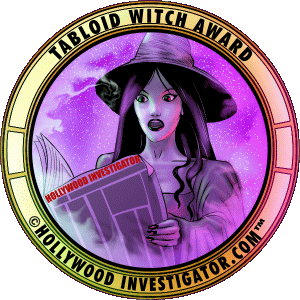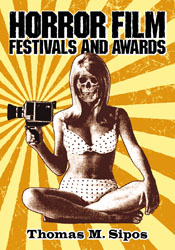|
How YOU can win!Or at least, become a better horror filmmaker. |
|
Contact: Send email to editor at hollywoodinvestigator dot com Past Winners & Official Screenings Special "Best Of" Screenings Blogs
|
The below article originally appeared in 2006, in Indie Slate magazine:
Eight Film Festival Mistakes to Avoidby Thomas M. Sipos
I'm in my third year of reviewing films for the Tabloid Witch Awards, sponsored by the Hollywood Investigator. It's an easy contest to enter; any short or feature length horror film is eligible, no entry fee required. Thus, I've received entries from across the spectrum of experience, from camcorder hobbyists, to film students, to professionals. I also see the same recurring mistakes among the losing films. Yet they're easy enough to avoid. Follow the below rules, and your film should be far more competitive in any festival you enter.
1. Writing Counts
"If it ain't on the page, it ain't on the stage." If you insist on writing your own script, you must study the art of storytelling as seriously as you'd study your camera. Too many filmmakers think screenwriting is only about format. Too many directors want to be "auteurs" and write their own scripts without learning the art of storytelling. If you're not a writer, and don't plan on learning the craft, then find someone who is. Successful directors often film someone else's screenplay. There's no shame in it. Poor writing creates many problems, such as...
2. A Vignette Is Not a Story
I've seen too many entries that confuse the two. "X rises from the grave and kills Y. The End," or "Zombies eat people. The End." Nor should you rely on a (often predictable) twist. "X is a serial killer who dates Y who turns out to be a vampire. The End." I've probably seen over a thousand horror films and TV shows so I know every "surprise" ending. Festival screeners tend to be well-versed in cinema history, especially in their festival's genre, so don't rely on your film's ending. You need more. Tell a story. And if you don't know what that is, see Rule 1.
3. Keep It Short and Sweet
Even a good film can be ruined by fat. Rich Mauro trimmed Mole to its perfect length. Distributors had advised Mauro that a one hour feature was a hard sell, but Mauro chose the best length for his tale of reporters seeking "mole people" in the abandoned subway tunnels under Manhattan. And it worked. Apart from winning a Tabloid Witch for Best Horror Feature Film (and Best Actress, and Best Supporting Actor), Mole also found distribution as part of a four film horror DVD package. Jamie Renee Williams's Slinky Milk (Honorable Mention), a black and white surreal film reminiscent of Un Chien Andalou, was intriguing at its five minutes. Were it a half hour, it would have overstayed its I've seen many losing entries that would have been stronger at half their lengths — films sabotaged by overlong expository shots, or directors in love with shots that fail to contribute to the story, or characters wandering around or engaging in pointless chatter. If a line is unnecessary to the story, don't say it. And if a line is necessary, say it in a way that's sharp, funny, clever, intriguing, memorable, or interesting. Dialogue should reveal character or move the story forward. Characters should not sound alike. Vapid chatter that achieves nothing may sound realistic, but banal banter makes for a dull film.
4. Acting Counts
Acting quality was the single biggest element separating winning films from the losers. Actors who are wooden, self-conscious, affectatious, or chew scenery can tank an otherwise decent film. I rejected one film that did a decent job of recreating the 1860s, in costumes and furnishings, only to populate this period piece with some painfully bad acting. There's no excuse for this. Big cities teem with trained actors willing to work cheap, or even for free. And even small towns usually have a college or community theater with trained actors. Of course, I've also seen horror "parodies" in which I suspect the director thought his bad cast was an asset. Wrong. An amateurish cast rarely produces a film that's "so bad it's good," but more often a film that's "so bad it's unwatchable." If you still insist on casting your friends and family, insist they get professional training. Seriously. Otherwise, you're shooting a home movie, and home movies can rarely compete against polished work.
5. It Doesn't End With the Shoot
6. Sound Counts
George Lucas understood this, which is why he founded Skywalker Sound. Christopher Alan Broadstone also understands this, which is why his Human No More (Best Sound, Best Actor, and an Honorable Mention) is a densely layered audio feast. And he did it with off-the-shelf computer programs like Bias Sound Soap and Bias Peak 4. It didn't require much money, only much effort.
7. Rule Are Guidelines
Rules can be broken. Human No More is a vignette rather than a story. And Slinky Milk has no story and no trained actors. But Broadstone's film remains powerful because of its artistry and originality; and Williams's experimental genre doesn't require a story or acting. Even so, rules are rules because they usually work. Violating them is a risk that rarely pays off.
8. Entertain Us
While skillfully shot and acted, Cadaverous and SuperStore are conventional horror tales of no great originality. Yet each won an Honorable Mention because, while we can predict their endings, these films maintain our interest. They entertain us. The writing contains no fat and the story moves at a good pace. We are not bored or driven off by an amateurish cast. These eight rules are simple to understand, but require much study and effort to master. However, a film that is well-written, well-acted, with beautiful visuals and a clear soundtrack, and is entertaining to boot, will more likely win an award.
What Does It Take to Win a Tabloid Witch?
Some past Tabloid Witch winners have placed their short films on YouTube. You can see their winning films at the bottom of the pages for 2004, 2006, 2007, 2008, 2009, and 2011. How do YOUR films compare?
This book is neither "artsy fartsy" nor "dummied down." It's written in an intelligent, yet accessible prose style. It's perfect for smart filmmakers who know how to use a camera (i.e., which buttons do what), but want to learn how to use their cameras well. You might also learn something about film aesthetics in one of our recommended blogs (left). We also recommend Sipos's Horror Film Festivals and Awards, for an inside peek "behind the scenes" at dozens of horror film festivals -- and listings for over 200! |
"Hollywood Investigator" and "HollywoodInvestigator.com" and "Tabloid Witch" and "Tabloid Witch Award" trademarks are currently unregistered, but pending registration upon need for protection against improper use. The idea of marketing these terms as a commodity is a protected idea under the Lanham Act. 15 U.S.C. s 1114(1) (1994) (defining a trademark infringement claim when the plaintiff has a registered mark); 15 U.S.C. s 1125(a) (1994) (defining an action for unfair competition in the context of trademark infringement when the plaintiff holds an unregistered mark).


 welcome.
welcome. 
